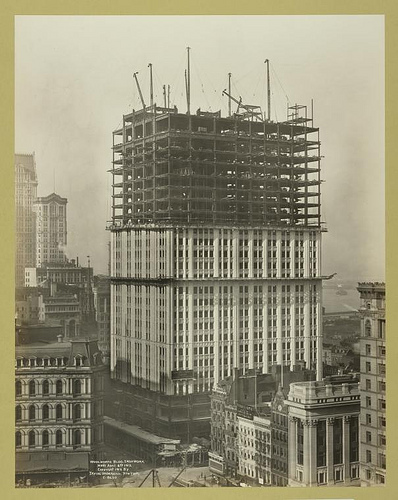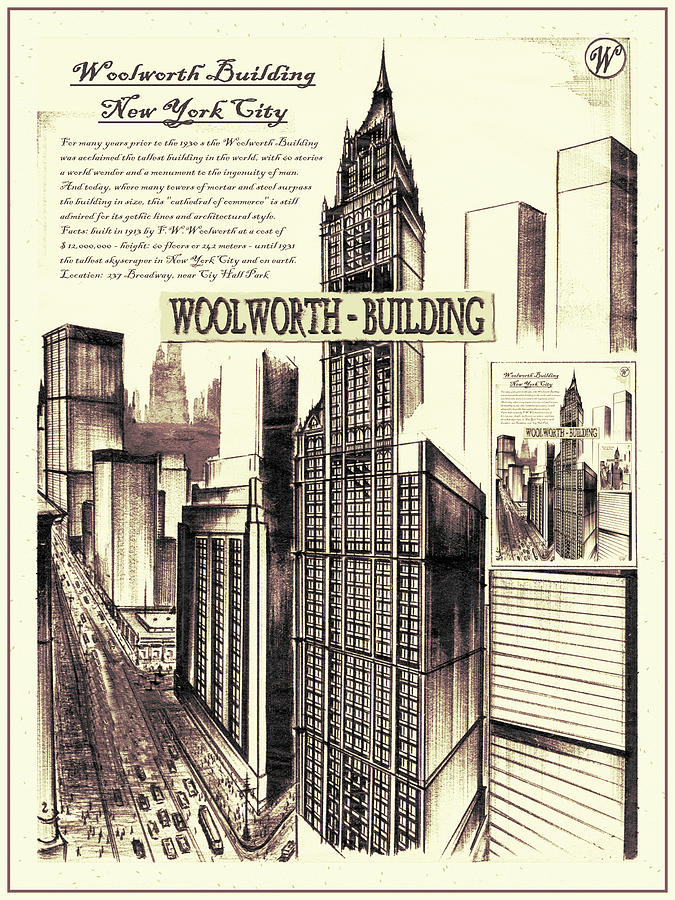I've been digging into research for a new sweet romance novel and one historical fact that caught my interest was the opening of the world's tallest building in 1913.
The Woolworth Building opened in April of that year in New York as not only the tallest building in the world but the second tallest structure (the Eiffel Tower was the tallest). At 60 stories high, the building soared 792 feet above Broadway between Park Place and Barclay Street in downtown Manhattan.
 Frank W. Woolworth, the chief executive of the F.W. Woolworth Company, owned 318 five- and ten-cent stores across the United States, Canada, and England. In April 1910, he set plans in motion to add to his empire through a new building that would make it's mark not just in New York, but the world.
Frank W. Woolworth, the chief executive of the F.W. Woolworth Company, owned 318 five- and ten-cent stores across the United States, Canada, and England. In April 1910, he set plans in motion to add to his empire through a new building that would make it's mark not just in New York, but the world.He commissioned architect Cass Gilbert to design a masterpiece. The Singer Sewing Machine Company headquarters, completed in 1908, was the tallest building in the world until the Metropolitan Life Insurance Company completed the Metropolitan Life Tower in 1910, taking over the title.
Woolworth wanted his building to steal the thunder from Met Life and become the tallest building in the world. He worked closely with Gilbert to make sure his goal was achieved. The total cost of the building expanded from $5 million to around $13.5 million. Woolworth financed the project in cash, giving him an unheard of degree of freedom in the design and construction.
Trained at the Massachusetts Institute of Technology, Gilbert attracted national attention for his work designing the Minnesota state capitol in St. Paul. When Woolworth engaged his talents for the new building, he created a Beaux-Arts design with ornate Gothic detail. It was said this style reflected Woolworth's vision of himself as a descendant of the great medieval merchants of the past.
Construction set a record for speed as the massive base of the building stretched over a full block and quickly took shape. A slender tower soon emerged over a steel frame, and garnered world-wide acclaim. The entire design soon became a model for skyscrapers that many copied for years.
The building won widespread acclaim for its steel-frame structure as well as interior and exterior appearances. The white terracotta facade featured subtle colored accents while the interior appeared luxurious.
A cathedral-like lobby with mosaics, sculptures, and a gold-decked ceiling added to the sumptuous atmosphere. It featured a water supply system, high-speed electric elevators, offices, a shopping arcade, health club, barber shop, restaurant, and social club.
The Woolworth headquarters occupied a mere floor and a half of the new building, leaving ample space for others to rent.
The building remained the tallest in the world for 17 years, until the Chrysler Building was completed in 1930. The Empire State Building opened in 1931, drawing both. Made a National Historic Landmark in 1966, the Woolworth Building remains one of the tallest buildings in New York City.
After spending her formative
years on a farm in eastern Oregon, hopeless romantic Shanna Hatfield turns her
rural experiences into sweet historical and contemporary romances filled with
sarcasm, humor, and hunky heroes.
When this USA Today bestselling author isn’t writing or covertly hiding
decadent chocolate from the other occupants of her home, Shanna hangs out with
her beloved husband, Captain Cavedweller.
Shanna loves to hear from readers. Follow her online at:
ShannaHatfield | Facebook | Newsletter | BookBub | Pinterest | Goodreads
| You Tube
| Twitter
Find Shanna’s books at:
Amazon
| Amazon
UK | Barnes &
Noble | Smashwords
| Apple
| Audible






No comments:
Post a Comment